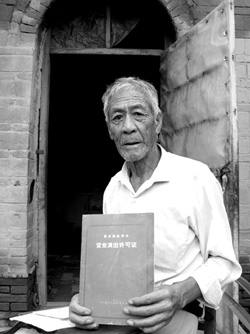
 Xihe Dagu
Xihe Dagu
Location: Zhang Village of Hebei Province
Artists: Xing Tiankun(74)
Xihe dagu forms the biggest family in the Dagu clan. It has a very long history with a huge audience in Northeast, Northwest, and North China including Hebei province and Tianjin and Beijing municipalities, and in East China's Shandong province.
Xihe dagu used to be sung and spoken in Hebei dialect. At the early stage, stories were mostly medium length or long, such as the Generals of the Yang Family and Generals of the Hu Family. When Xihe dagu became popular in Beijing, it underwent reformation by the noted artist Zhao Yufeng, who changed the Hebei regional pronunciation and made it more akin to the Beijing dialect.
Around 1940, other artists emerged, such as Ma Liandeng and Ma Zengfen, a father-and-daughter team who sang short stories without narrative. By this time, the style of singing had been enriched and the clapping was far more diverse.
This particular dagu originated from the Xianzishu and Muban dagu in the central area of Central China's Hubei Provincein the midQing Dynasty(1644-1911). It officially got the name of Xihe Dagu while being performed in Tianjin during the 1920s.
Xihe dagu has lots of traditional items of either long or short length. The contents are mainly war stories of the past dynasties, historical romances, folk stories, popular novels, fairy tales, fables, and jokes, and so on. Among them, quite a few items reflect the thoughts, feelings, and hopes of the working people, feature labyrinthian (maza-like) plots and vivid language, and inherit the good tradition of folk literature in China.
After the founding of the People's Republic of China in 1949, a lot of outstanding traditional items of Xihe dagu were rearranged in terms of contents, and quite a few new items reflecting the Chinese people's resistance against oppression and eulogizing the realistic life came into being.
Related:Finding the Root of Beijing Dagu Shu(I)
